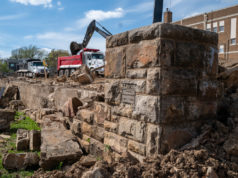The controversy over tar sands pipelines is splattered with — and fueled by — stories of leaks and ruptures that will change the lives of communities for years to come.
As an example of just how long a small leak can go undetected, Deaver described a Midland case he’d been involved in where an estimated 30 barrels of crude oil had spilled. “The baseline for reporting a spill is 50 barrels, so it wasn’t even reported.” Years later, he said, when someone decided to build a new housing development on that land, it was discovered that the oil spill was actually closer to 20,000 barrels –– that is, more than 800,000 gallons. “It just never stopped leaking and didn’t pool on the surface, so no one noticed it.

“The thing you need to know about pipeline safety is that it’s not really about public safety at all. It’s about the public’s perception of their safety,” he said.
In July 2010, Enbridge Energy’s 6B pipeline, which runs through Indiana and Michigan carrying tar sands bitumen, suffered a 6-foot rupture near Talmadge Creek, Mich. Alarms went off at the Enbridge headquarters in Alberta, but 18 hours passed before the company shut the pipe down. By that time an estimated 877,000 gallons of tar sands bitumen had escaped into the creek and made its way into the Kalamazoo River. More than 35 miles of the river had to be closed. Hundreds of resident were affected: Dozens became ill, and Enbridge ended up buying more than 100 homes because of their proximity to the spill and the poisonous gases that were released. The gases included the carcinogen benzene and a cocktail of volatile organic chemicals.
To date, the cleanup has cost Enbridge nearly $900 million, and it’s far from finished. In March, the Environmental Protection Agency ordered Enbridge to remove at least 100,000 gallons of tar sands bitumen that remained in the river bottom sediment.
Enbridge had known about the possibility of line failure for at least five years prior to the Kalamazoo disaster. An internal report in 2005 indicated that the company was aware of at least 15,000 defects in the 40-year-old pipe. And a 2004 pipe integrity report done for Enbridge by the United Steel Workers pinpointed a large crack — due to corrosion — in the exact weld that ruptured six years later. Rather than go to the expense of fixing the weaknesses, however, Enbridge continued to use the pipeline until disaster struck.
In a notice of violation issued in July 2012, the Pipeline and Hazardous Materials Safety Administration wrote that Enbridge had not demonstrated that it had attempted any remediation of the corrosion or crack anomalies that were identified in 2004 and 2005.
Why would Enbridge not repair a line with so many known defects for so many years? During the six years between the first notice of the cracked weld and the rupture, the company made hundreds of millions of dollars on the pipeline.
Although the cost of their cleanup is astronomical — and will go higher because the company is replacing about 80 miles of the pipe — the total fine levied against Enbridge by the U.S. Department of Transportation was just $3.7 million.
As for people who are harmed, by serious health problems or the loss of a home or long-term environmental damage to their land, “They simply don’t matter to that [corporate] culture,” said the former industry executive. “And they never will until some of the executives who foster that willful blindness in the culture are made to go to jail.”
The Mayflower, Ark., spill in March was the result of a 22-foot rupture in ExxonMobil’s Pegasus line. Huge amounts of tar sands bitumen washed down storm drains and into a cove that’s part of Lake Conway. Arkansas’ Department of Environmental Quality concluded that no perceptible amount of that spill has reached the main body of Lake Conway, a 7,000-acre man-made recreational lake built by the U.S. Army Corps of Engineers.
As in Michigan before the Kalamazoo River spill, an internal inspection report indicated that ExxonMobil knew as long as three years ago of 4,000 defects in the Pegasus line, just in the stretch between Conway, Ark., and Corsicana, Texas. The report was made public by U.S. Rep. Tim Griffin of Arkansas after the Mayflower spill.
Deaver said the real number of defects might be several times greater, but no one will ever know because of the limitations of detection equipment.
“What they found were 4,000 metal-loss defects — where the metal was thinner than it should be. And that’s going to be natural when a line is 65 years old. But those are easy to detect. Things like cracks in the welds are simply undetectable unless you actually [uncover] the pipe and look. And even then you’ll miss [some].”
Much of the spill was contained in the neighborhood before it reached the cove. Nonetheless, six months after the event, the Arkansas environmental quality agency said the cleanup is far from over. Tammie Hynum, the agency’s hazardous-waste division chief, said last week that the agency is still investigating the spill’s effects downstream and that there are some “constituents of the crude left in the cove.” She said the agency intends to ask for more sampling of water and soil in the area and may require further remediation
Subra agreed.
“All indications are that there is still contamination in that area,” said Subra, who collected data at the Mayflower site. “People who live around the cove have been severely affected by the emissions from the material that was in the subsurface and in the soil on the surface. They’re getting headaches, nausea, skin rashes, dizziness, shortness of breath.” Subra has studied health effects of the oil and gas industry in the Barnett and Eagle Ford shale regions of Texas and in many several states.
The Mayflower residents, she said, will continue to be affected because each rainfall creates a new exposure to the toxins in the tar sands bitumen as more of the material rises to the surface.
ExxonMobil sent an e-mail in response to several questions about that spill. “The Pegasus pipeline remains shut down and it will only be restarted once we and the Pipeline and Hazardous Materials Safety Administration are convinced it is safe to do so,” the e-mail said. “At this time, it’s still premature to speculate on future plans for the pipeline until the investigation into the cause of the incident is completed.”
The company did not respond to the other questions.
********












Green NGO’s, citizen groups and impacted landowners efforts have all failed in preventing Keystone XL South , which is in the ground in TX and OK and close to start-up. It connects to Keystone 1 in Cushing, OK so tar sands dilbit now has a direct route to the TX Gulf Coast refineries. The line still faces several legal challenges from TX landowners and the Sierra Club. Up to now the courts have all sided with the pipeline companies.
The Pegasus line will be eventually be twinned because I believe it will never be restated and Seaway reversal and twinning is a done deal. There are no teeth in the current regulations and laws to prevent these types of projects from being essentially rubber stamped or successfully challenged in the courts.
The spill victims in Michigan and Arkansas are facing lifelong health problems due to exposure to toxic tar sands dilbit spills. For the most part they are forgotten. Yet we see more and more tar sands pipeline projects including new and reversed/re-purposed and interconnected lines flying through a lax regulatory system.
Nothing will change until new laws are passed to address the serious and valid concerns surrounding new and reversed/re-purposed tar sands pipelines. New rule making is really the only way to make a change to a broken system that seems to be incapable of policing itself.
Sitting in trees in TX or protesting Keystone XL in DC raises awareness of the issues but it has not and will not change the harsh reality that landowners face when they have a toxic, tar sand pipeline forced on them. Keystone XL South is expected to be on line by late 2013 early 2014. Epic Fail!
A serious part of the problem with the Pipeline and Hazardous Materials Safety Administration (PHMSA) is that they advocate for the pipeline industry instead of regulating it. One aspect of this is their continuing misrepresentation of pipeline safety. I recently reviewed one of PHMSA’s document which grossly misrepresents pipeline safety as continually getting better even though their own data shows that is not true. The review (it is easy for anybody to read and understand) can be found at my website: http://www.icogitate.com/~oildrop
In another example, an October, 2012 report signed by Transportation Secretary Ray Lahood ignored the eight deaths and 51 injuries of the San Bruno, California gas pipeline explosion and fire that destroyed 38 homes. Those numbers don’t fit nicely into the ever-improving safety story PHMSA likes to tell.
When such faulty reports are issued by PHMSA and high government officials it is very difficult for ordinary citizens to effectively advocate for legislative action that would improve pipeline safety.
I grew up in Richardson and I would hate to see those water sources fouled by the pipelines under the reservoirs. One of the points in my review is that older pipes become much more dangerous. In the review you will find a graph produced from PHMSA data which demonstrates that 40-year old pipelines are about 10 times more likely to fail than new pipelines. The Richland-Chambers and Cedar Creek reservoirs are in danger. The unknown is when, not if, a pipeline failure will occur.
I’m moving again and I don’t see me owning property in Texas again. Texas is a good place for polluters but not so great for people.